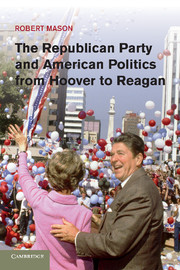Book contents
- Frontmatter
- Contents
- Acknowledgments
- Introduction
- 1 “From Old Home Melodies to Jazz Music”: 1928–1933
- 2 “As Maine Goes, So Goes Vermont”: 1933–1939
- 3 “The Simple Barefoot Wall Street Lawyer”: 1939–1945
- 4 “Liberty versus Socialism”: 1945–1953
- 5 “Modern Republicanism”: 1953–1961
- 6 “A Choice, Not an Echo”: 1960–1968
- 7 “There’s a Realignment Going On”: 1968–1976
- 8 “You Are Witnessing the Great Realignment”: 1977–1989
- Conclusion
- Archival Sources
- Index
- References
7 - “There’s a Realignment Going On”: 1968–1976
Published online by Cambridge University Press: 05 December 2011
- Frontmatter
- Contents
- Acknowledgments
- Introduction
- 1 “From Old Home Melodies to Jazz Music”: 1928–1933
- 2 “As Maine Goes, So Goes Vermont”: 1933–1939
- 3 “The Simple Barefoot Wall Street Lawyer”: 1939–1945
- 4 “Liberty versus Socialism”: 1945–1953
- 5 “Modern Republicanism”: 1953–1961
- 6 “A Choice, Not an Echo”: 1960–1968
- 7 “There’s a Realignment Going On”: 1968–1976
- 8 “You Are Witnessing the Great Realignment”: 1977–1989
- Conclusion
- Archival Sources
- Index
- References
Summary
“Now for the first time since Teddy Roosevelt, it is we who have the initiative, we who stand for sweeping change, we who stand for restoring power to the people – and the other side on Capitol Hill who suddenly become the party of the Status Quo.” Meeting with congressional Republicans in early 1971, Richard Nixon argued that it was an important moment for the party. According to Nixon, the party’s few post–World War II victories had depended on opposition – opposition to postwar frustrations in 1946, to “the mess in Washington” in 1952, and to “crime and Vietnam and campus anarchy and riots” in 1968. An opposition psychology pervaded the party, he told them, characterizing its congressional politicians’ actions even when Republicans won power. It was this reliance on opposition – together with the Republican refusal to outspend Democrats – that accounted for the party’s minority status, Nixon said. A few days earlier the president had outlined his proposals for “sweeping change” in his State of the Union address, in which he indulged his taste for political hyperbole by speaking of a “new American revolution.” This intended revolution involved welfare reform, environmental protections, healthcare, revenue sharing (which sought to shift control over spending in certain areas from the federal government to the states and localities), reform of the federal government, as well as the assurance of prosperity, fed by an expansionary budget. Together, the initiatives amounted to a Republican version of activist government: an expansion of the welfare state but a reassertion of state and local responsibility for its oversight, therefore compromising the party’s antistatism while maintaining a stress on its skepticism of federal action.
Nixon’s message to congressional Republicans repudiated the approach to electoral politics that had characterized his own career. His understanding of the party’s minority status had discouraged him from any defense of a conservative alternative to New Deal liberalism, still less any promotion of such an alternative. Nixon believed that voter support for activist government accounted for the Democratic Party’s electoral advantage, and that any campaign engagement with related questions was unlikely to win converts but sure to elevate the salience of those issues – thus reminding a majority of Democratic strengths. This is why, according to Nixon’s perspective, Republican success depended on Democratic failure, rather than any affirmative mobilization in support of a nonliberal agenda. A related strategy looked for other issues, beyond the key concerns of New Deal liberalism around which U.S. politics had usually centered now for a generation. Nixon had encouraged Republicans to cultivate different foci of campaign debate, to the Democrats’ disadvantage. His advocacy of anticommunism as such an issue during the 1940s and 1950s was the preeminent example of this strategy, a tactic that helped to earn him his controversial reputation as “Tricky Dick.” The nature of his advice to fellow Republicans in early 1971 was thus a departure from his previous insights about the implications of the party’s minority status. It did not represent a surrender of his earlier argument, however. Nixon still believed that any emphasis on a conventionally conservative response to New Deal liberalism was a sure route to defeat. But he now thought that a Republican version of activist government was worthy of policy development and political defense.
- Type
- Chapter
- Information
- The Republican Party and American Politics from Hoover to Reagan , pp. 216 - 246Publisher: Cambridge University PressPrint publication year: 2011



